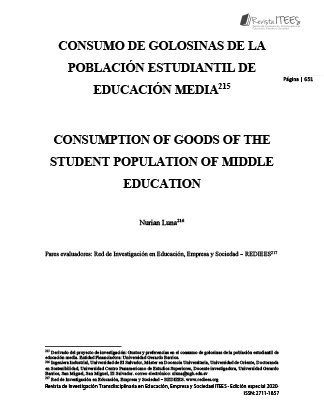XXXIII. CONSUMO DE GOLOSINAS DE LA POBLACIÓN ESTUDIANTIL DE EDUCACIÓN MEDIA
##plugins.themes.bootstrap3.article.main##
Resumen
En El Salvador seis de cada cien niños, tienen sobrepeso, 31.8% de mujeres y 19,2% de
hombres padecen sobrepeso (Ministerio de Salud El Salvador, 2017). Existen diversos
factores influyentes en que una persona tenga sobre peso, entre ellos: hábitos alimenticios
familiares y acceso a alimentos saludables. Esfuerzos de parte del Gobierno buscan mejorar
esta situación, implementando la Normativa de tiendas y cafetines escolares saludables, que
disminuyó la cantidad de productos disponibles para los estudiantes. El objetivo del estudio
fue conocer los gustos y preferencias de los estudiantes de educación media y la incidencia
de compra, brindando información para nuevos productos saludables que se adecuen a la
normativa y a los gustos de los estudiantes.
Para esta investigación se elaboraron instrumentos para los proveedores y los estudiantes, la
muestra fue seleccionada en base a criterios, entre ellos que el centro escolar cuente con
infraestructura de cafetín propia, estudiantes desde kínder hasta noveno grado, mayor
cantidad de matrícula.
Los resultados muestran que las pupusas, refrescos y mango son preferidos al momento de
comprar. 50% de los estudiantes encuestados compran en los cafetines escolares una vez al
día, mientras que el 26% compran por lo menos dos veces al día.
Los resultados de esta investigación son de relevancia para los dueños de cafetines y
emprendedores que buscan nuevas opciones de productos saludables ya que los resultados
son específicos en cuanto a los productos preferidos por los estudiantes.
Download Statistics
##plugins.themes.bootstrap3.article.details##
Comedor escolar, Alimento, Estudiante, Nutrición, Consumidor
Villalmanzo Francisco, A., & Lopera Ramírez, S. (2006). Estudio descriptivo sobre
hábitos alimentarios en el desayunoy almuerzo de los preadolescentes de Viladecans
(Barcelona). Nure Investigación. Obtenido de https://bit.ly/3faw7sa
Chacón-Orduz, G., Muñoz-Rincón, A., & Quiñónez-Mosquera, G. A. (2017). Descripción
del mercado de los snacks saludables en Villavicencio, Meta. Revista Libre Empresa,
33-45. doi: https://bit.ly/38W9pSh
Hernández Sampieri, R., Fernández Collado, C., & Baptista Lucio, P. (2014). Metodología
de la investigación (6ta. edición ed.). México: McGrawHill Education.
Malhotra, N. (2008). Investigación de mercados (Quinta edición ed.). México: Pearson
Educación.
Martínez, N. (2019). Sistematización de la experiencia en la aplicación de la normativa para
tiendas y cafetines escolares en tres centros educativos públicos. Centro para la
defensa del consumidor - Fundación Kenoli. San Salvador: MC Impresores.
Ministerio de Educación de El Salvador. (17 de junio de 2017). Normativa de tiendas y
cafetines escolares saludables. San Salvador. Obtenido de https://bit.ly/2OgiQlT
Ministerio de Educación El Salvador. (2018). Datos 2018 por Centros Educativo Matrícula
Inicial y final: Repetidores, Sobreedad, Aprobados, Reprobados, Desertores. San
Salvador. Obtenido de https://bit.ly/2ZgwGLH
Ministerio de Salud El Salvador. (27 de 04 de 2017). Noticias ciudadanas. Obtenido de
Ministerio de Salud: https://bit.ly/3j548wj
Organización Mundial de la Salud. (2004). Estrategia mundial sobre régimen alimentario,
actividad física y salud. Obtenido de Estrategia mundial sobre régimen alimentrio,
actividad física y salud.
Rodríguez, M. C., Guerrero, M. B., & Sandoval, R. (2002). Guía técnica cultivo de mango.
San Salvador. Obtenido de https://bit.ly/3finjjW
Salud, M. d. (27 de abril de 2017). Ministerio de Salud, Gobierno de El Salvador. Obtenido
de Noticias ciudadanos/as: https://bit.ly/3hoQYZu
Salvador, M. d. (2018). Datos 2018 por Centros Educativo Matrícula inicial y final:
Repetidores, Sobreedad, Aprobados, Reprobados, Desertores. San Salvador.
Software para encuestas QuestionPro. (13 de 08 de 2018). QuestionPro. Obtenido de
https://bit.ly/38J3iko
Soto, B. (2009). Comida chatarra en los centros escolares. San Salvador. Obtenido de
https://bit.ly/2VZT4qj.





